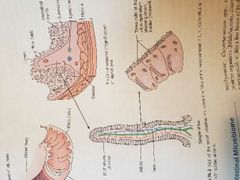![]()
![]()
![]()
Use LEFT and RIGHT arrow keys to navigate between flashcards;
Use UP and DOWN arrow keys to flip the card;
H to show hint;
A reads text to speech;
10 Cards in this Set
- Front
- Back
- 3rd side (hint)
|
Hairlike projections seen on the folds of the wall of the small intestines are known as |

Villi |
|
|
|
The lining of the GI track is called |
Mucosa |
|
|
|
Gastritis |
Inflamation of the gastric mucosa. |
Associated with vomiting, nausea, user abdominal pain, burping and fever |
|
|
Dysentery |
Refers to a destructive disease of the mucosa, almost exclusively occurring in the colon. |
|
|
|
Jejuni |
The most common cause of GI disease in many areas of the United States. |
|
|
|
Cytotoxins produced by C.difficile is |
Most useful marker for diagnosis of psudomembranous colitis (PMC). |
|
|
|
Neurotoxins produced by Clostridium botulinum |
Prevents the release of the neurotransmitter acetylcholine at the cholinergic nerve junctions casting flaccid(rag doll) paralysis . |
|
|
|
Causative agent for antibiotic-associated hemorrhagic colitis (AAHC) is; |
Toxin-producing Klebsiela Oxytoca |
|
|
|
Laboratory diagnosis of GI tract infections |
Stool specimen for bacterial culture Stool specimen for ova and parasites Stool specimen for viruses |
|
|
|
Direct detection of agents if Gastroenteritis |
Wet mount Stains (Gram stain; eg. many thin, comma shapes gram-negative bacili may indicate campylobacter infection, if vibro infection has been ruled out. ) |
|

